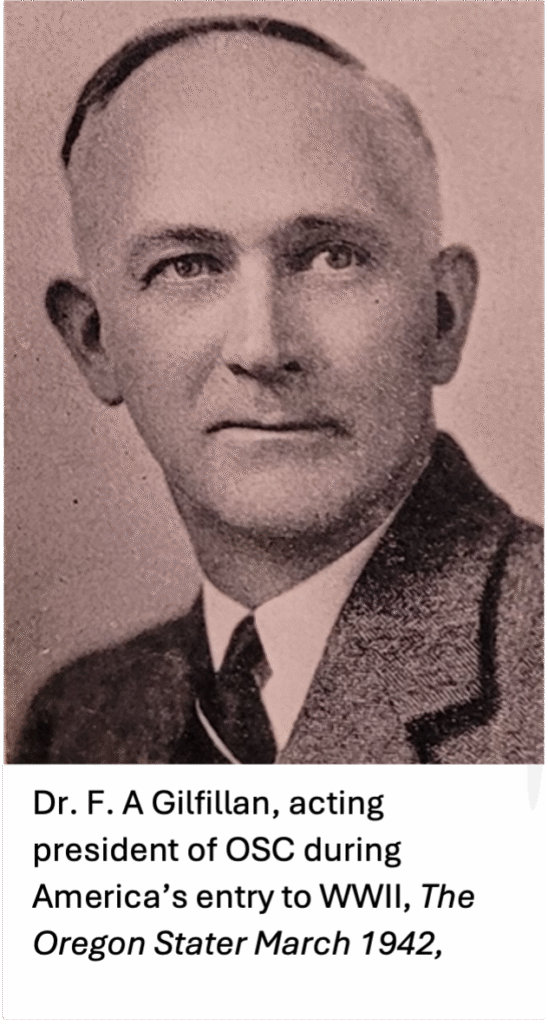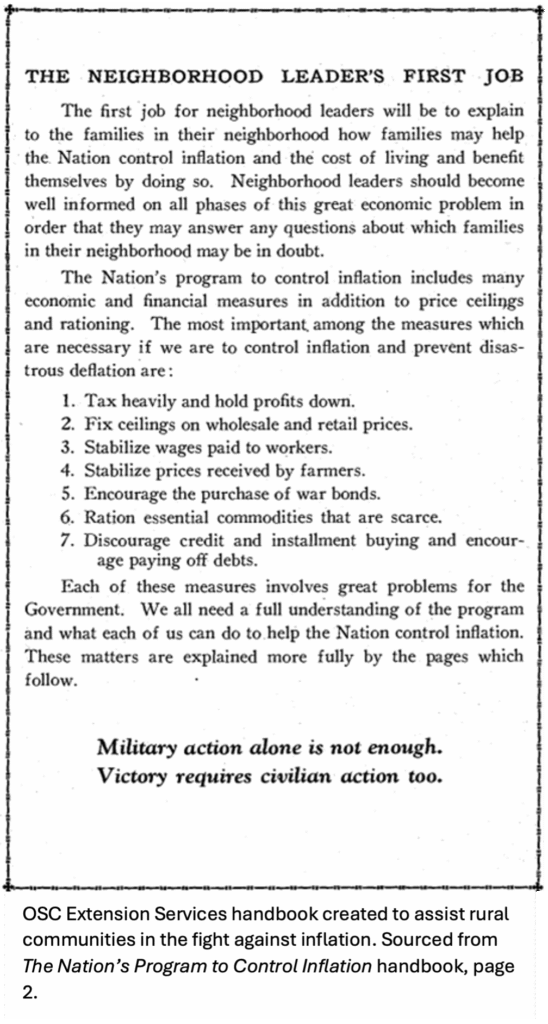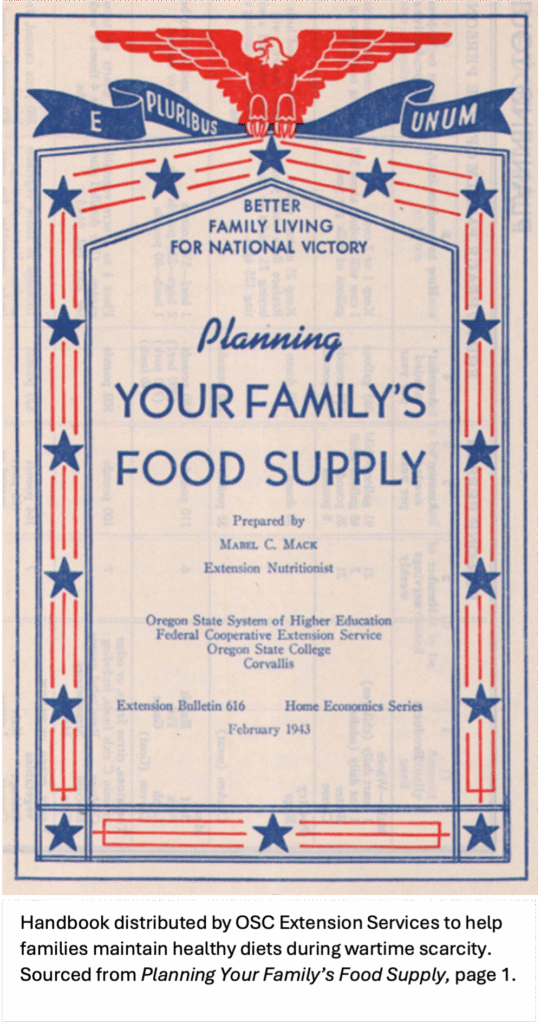During winter term 2025 Dr. Kara Ritzheimer’s History 310 (Historian’s Craft) students researched and wrote blog posts about OSU during WWII. The sources they consulted are listed at the end of each post. Students wrote on a variety of topics and we hope you appreciate their contributions as much as the staff at SCARC does!
Blog post written by Tanner Maynard.

The December 7, 1941 attack on Pearl Harbor by the Imperial Japanese Navy forced the American people to recognize that the war raging across the globe was coming to them, whether they wanted it or not. Men stood in recruitment lines, women signed up for the Red Cross, and assembly lines transitioned from producing cars to producing tanks. The attacks galvanized the nation’s fighting spirt and Americans were once again willing to enter the fray. However, the war overseas would not be won through spirit alone. It had been more than two decades since the United States’ foray into World War One and Americans were not accustomed to, nor prepared for, the rigors of war. Technicians needed training, communities needed organizing, and those on the home front needed more practical knowledge to support the war abroad. Land-grant universities like Oregon State College (OSC) answered the nation’s call to arms by addressing the country’s educational needs.
America faced a critical shortage of engineers, doctors, and scientists for wartime needs at the onset of the United States’ entry into World War Two. In recognition of this shortage, the OSC campus almost immediately began to transition from traditional campus life towards a wartime curriculum. A headline from the March 1942 issue of The Oregon Stater, the campus’s monthly magazine, reads: “Wartime Demands Anticipated…Defense Activities at Oregon State College Meet and Exceed Suggestions of Wartime Commission.”[1] The article states that, earlier that month, under the direction of acting president Dr. F.A. Gilfillan, OSC had committed to accelerate academic schedules. College administrators planned summer classes for the upcoming term that would offer up to a maximum of 18 credits for the session and allow undergraduates in critical sectors, such as engineering and physics, to graduate earlier. OSC also contributed to the war effort by creating nutritional programs, pre-nursing courses, first aid, fire prevention training, and additional ROTC work.[2] While many of these courses were educational, the newly established physical program, for example, offered dancing classes, field games, and swimming courses, all under the supervision of OSC physical education staff.[3]
OSC was one of the first campuses in the nation to offer physical conditioning courses aimed at national defense for women.[4] While these courses were not designed to prepare women for physical combat, they were intended to condition who would go on to work in canneries, field labor, or at aid stations through the course of the war, as the Oregon State Barometer explains.[5]
By 1943, the accelerated wartime curriculum began to accommodate incoming undergraduates who participated in the similar high school Victory Corps program. The program was designed to provide some basic military training to male and female high school students. Undergraduates would be eligible to transfer their Victory Corps experience over in the form of degree credits to further accelerate their graduation date and meet the expertise required of the war.[6] Summer classes and Victory Corps workshops could give freshmen a head start on their graduation date. The wartime curriculum prepared students for their future trials. However, OSC did not just offer curriculum for its own students.
The military quickly realized its direct need for technical expertise beyond the home front. In 1943, the Army and Navy collaborated to create the Army Specialized Training Program (ASTP) under the Ninth Service Command. The Service Command’s intent was to train officers in subjects such as advanced engineering and other sciences. Qualified civilians, such as campus faculty, would conduct this training on a contract basis. OSC was the first institution on the West Coast to secure one of these contracts.[7] Oregon newspapers quickly praised OSC for accepting 500 soldiers in the coming spring term of 1943.[8] The ASTP required the soldier students to adhere to rigorous military and professional standards. An ASTP manual sent to the OSC President details the contracted curriculum the campus would provide, as well as the advanced expectations of those who participate in the program.[9] The program would not survive the end of the war due to more pressing manpower requirements, such a need for riflemen in late 1943 and early 1944. However, OSC continued to support the program, with contracts extending as far as July 1945.[10] Wartime curricula and the ASTP, while significant presences on the campus, were not the only educational programs offered by OSC in support of the war.
President Roosevelt’s administration confronted a monumental task in mobilizing the American people and the economy for war. In his historical analysis Wartime America, historian Dr. John Jeffries describes the complexities of mobilization and how the executive branch created various organizations to assist in that endeavor. “America’s entry into the war in December 1941 galvanized mobilization agencies, the production of war goods, and the management of the economy, but largely along lines already established. In January 1942, FDR created the War Production Board (WPB)…Designed to exercise general responsibility over the economy in order to effect conversion to war production, restrict nonessential economic activity, and coordinate materials and production priorities.”[11] By themselves, these programs would mean relatively little if the public did not know how to help support them in their day-to-day lives. You may ask an individual to do their part to control inflation, but it will not amount to much if people don’t know what that is or how they can make an impact. Luckily, OSC was well-equipped for educational outreach.

Extension Services offered by land-grant universities and colleges like OSC had a long tradition of educational outreach long before, and long after, the entry to the war. Dr. Wayne Rasmussen, former chief historian for the United States Department of Agriculture, remarked in his historical account Taking the University to the People, “Extension has been a force for sustained, rational change that improves the quality of American life. It has taken the university to the people. Indeed, it is the university of the people.”[12] He adds, “the Extension Services played pivotal roles in the nation’s survival through three major emergencies – World War I, the Great Depression of the 1930s, and World War II.”[13]
While OSC’s wartime curriculum met the educational needs of the nation on campus, its Extension Service stood ready to address them off grounds. Extension Services outreach ranged from providing practical information to local communities in support of national programs, such as the effort to control inflation, to indirect support through comprehensive diet plans and fire prevention training.
Handbooks were particularly useful to this end. One such example is the Victory Begins at Home program booklet in which OSC’s Extension Services developed a guide to assist local leaders in supporting national goals.[14] The manual emphasized the need for community leaders to keep their neighborhood informed about wartime problems as well as activities that local communities could engage in, such as the collection of scrap iron and rubber or the establishment of Victory Gardens. Nutrition became a major focus of the war effort during 1942 and 1943. Establishing home food supplies and maintaining proper nutrition would allow families to be more resilient in the face of wartime shortages. In response, Extension Services distributed material to assist families in developing easy to follow diet plans.[15] Families received detailed instructions via guidebooks and workshops on how to keep and properly manage livestock, even in confined environments.[16] The potential threat of fire sabotage by enemy forces spurred the creation of the Emergency Farm Fire Protection program in support of the national Victory Garden initiative.[17] OSC’s Extension Services not only developed these types of programs, but ensured community access via the distribution of handbooks to local communities through meetings, workshops, or mailing lists.[18] OSC’s fire prevention and training programs were so successful that in 1942, the state organized the Keeping Oregon Green association. A 1942 thesis presented to the School of Forestry noted that the recent expansion of fire patrols in rural Oregon were directly attributable to the Oregon State College Extension Service.[19] These extra patrols would surely come in handy later that year when Japan attempted to drop incendiary bombs on the Oregon coast. However, not all programs were as tangible. In 1942, the President of the United States offered a plan to control inflation. Through workshops and booklets, Extension Services offered rural communities a comprehensive understanding of the causes of inflation, as well as tips for how individuals could assist their government in their attempts to control it.[20]

Educational institutions did not stand idly by while the rest of the nation went to war. Distributing a handbook or taking a course is not as flashy as raising a flag on a foreign island. However, that does not mean that the services offered by institutions were not valuable. Institutions like Oregon State College worked tirelessly to address the educational needs of a nation at war. Through wartime curriculum and the outreach of Extension Service, land-grant colleges directly supported the national efforts by ensuring America had the technical and practical knowledge to win the war.
[1] “Wartime Demands Anticipated…Defense Activities at Oregon State College meet and Exceed Suggestions of Wartime Commission,” The Oregon Stater, March 1942, 2, Oregon Digital, https://oregondigital.org/concern/documents/fx71bk75g
[2] “Wartime Demands Anticipated,” The Oregon Stater, March 1942, 3,16, Oregon Digital, https://oregondigital.org/concern/documents/fx71bk75g
[3] “Physical program Open to All OSC Women,” Oregon State Barometer, March 24, 1942: 1, Oregon Digital, https://oregondigital.org/concern/documents/8k71p720p#metadata
[4] “OSC Health Program Among Nation’s First,” Oregon State Barometer, March 24, 1942: 1, Oregon Digital, https://oregondigital.org/concern/documents/8k71p720p#metadata
[5] Eva Seen, “Physical education Department Offers Conditioning Activities,” Oregon State Barometer, March 24,1942: 1, Oregon Digital, https://oregondigital.org/concern/documents/8k71p720p#metadata
[6] “Fourth Quarter Summer Session Plans at OSC Announced by Dean Smith,” The Oregon Stater, February-March, 1943, 5, Oregon Digital, https://oregondigital.org/concern/documents/fx71bk89t?locale=en
[7] John Burtner, “Army Specialized training Program Set Up on Oregon State Campus,” The Oregon Stater,” (February-March, 1943), 3, Oregon Digital, https://oregondigital.org/concern/documents/fx71bk89t?locale=en
[8] “Oregon State Is Ready to Proceed on War Basis,” The Springfield News, March 11, 1943: 3, Historic Oregon Newspapers, https://oregonnews.uoregon.edu/lccn/sn97071003/1943-03-11/ed-1/seq-3/#words=college+Oregon+Oregon%27s+State+war
[9]“Army Specialized Training Program,” April 3, 1944, Oregon State University’s Special Collections and Archives Research Center (hereafter SCARC), President’s Office General Subject File, Army Specialized Training Program – Curricula, Contract manuals and curriculum material, 1943-1945,” Subgroup 6, Series 8, Sub-Series 41, Reel-Folder 34.79a, 215-238. Also available through, Oregon Digital, https://oregondigital.org/concern/documents/4m90dw941
[10] “Army Specialized Training Program” (April 1944), 7, Oregon Digital, https://oregondigital.org/concern/documents/4m90dw941
[11] John Jeffries. Wartime America: The World War II Home Front (Rowman & Littlefield, 2018), 17.
[12] Wayne Rasmussen, Taking the University to the People: Seventy-Five Years of Cooperative Extension (Iowa State University Press, 1989), 14.
[13] Rasmussen, Taking the University to the People, viii.
[14] Voluntary Community and Neighborhood Leadership in Oregon (Corvallis, Or. Federal Cooperative Extension Service, Oregon State College, 1942), 1-4, ScholarsArchive@OSU, https://ir.library.oregonstate.edu/concern/administrative_report_or_publications/41687k07k
[15] Mable Mack. Planning Your Family’s Food Supply (Corvallis, Or. Federal Cooperative Extension Service, Oregon State College, 1943), 1-5, ScholarsArchive@OSU, https://ir.library.oregonstate.edu/concern/administrative_report_or_publications/0g354k11p?locale=en
[16] James A. Harper and Clyde Walker, The Home Unit Poultry House. (Corvallis, Or. Federal Cooperative Extension Service, Oregon State College, 1943), 1-12, ScholarsArchive@OSU, https://ir.library.oregonstate.edu/concern/administrative_report_or_publications/5712mb02r
[17] A. S King, and R. H Sterling, Organizing for Farm Fire Protection in Oregon (Corvallis, Or. Federal Cooperative Extension Service, Oregon State College, 1942), 2. https://ir.library.oregonstate.edu/concern/administrative_report_or_publications/jd473122h
[18] A. S King, and R. H Sterling, Organizing for Farm Fire Protection in Oregon (April 1942), 3, ScholarsArchive@OSU, https://ir.library.oregonstate.edu/concern/administrative_report_or_publications/jd473122h?locale=en
[19] Eugene McNulty, Keeping Oregon Green: Handbook for Field Men of the Keep Oregon Green Association (June 1942), 5, ScholarsArchive@OSU, https://ir.library.oregonstate.edu/concern/undergraduate_thesis_or_projects/hq37vt27x?locale=en
[20] The Nation’s Program to Control Inflation (Corvallis, Or. Federal Cooperative Extension Service, Oregon State College, July 1942), 3-8, ScholarsArchive@OSU, https://ir.library.oregonstate.edu/concern/administrative_report_or_publications/fx719r33t





































